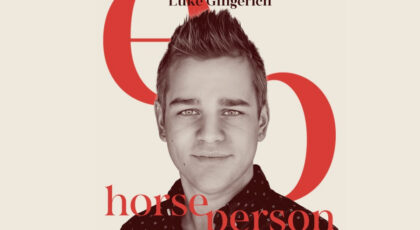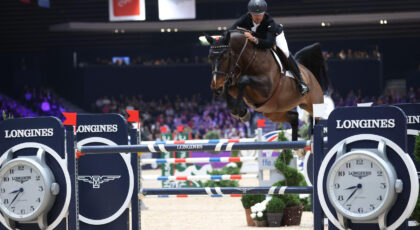Horse shows can be truly mystifying to the metropolitan journalist, as expressed by their often convoluted coverage.
While I won’t name exactly which publication has fallen victim to this teachable moment *cough*, I will say that as an athlete Mary-Kate Olsen deserves better sports recognition.
The thing is we would love for more mainstream media to cover equestrian events, so this isn’t an attempt to dissuade journalists from making valiant efforts to grasp our niche sport. We just want you to sound informed doing it. (Because horse people notice.)
So, to help non-horse journalists sound like overnight experts we’ve put together this comprehensive guide of common pitfalls to avoid.
Try to get over the outfits
“…she donned a black jacket over a white shirt and pair of matching white pants. She wore knee-high riding boots and a black helmet to protect her head while riding.”
If you find yourself wandering the grounds of a horse show with hopes of spotting a certain celebrity for your pop culture column, we know you might be dazzled seeing them in their authentic equestrian getup. Starlets might stand out to you, but take a look around and you’ll see it’s assuredly not because of their attire. The whole point is to look like everyone else. The dress code is actually a requirement to compete in the class.
So do recognize that the “full riding ensemble” is not an optional or expressive style statement, it is simply the required uniform to participate. (Baseball players also wear white tights and no journalists are commenting on that…)
Equestrians also have different celebrities than normal folk. So if you see a flock of mesmerized equestrian journalists encircling a seemingly ordinary, perhaps even rather old looking, individual, join in. You might meet a riding legend, learn something cool for another article, and we can officially adopt you into the fold.
Colors are confusing, but also not important
“Chestnut brown horse”
Mainstream media seems captivated by the colors of horses, yet don’t seem to know the colors and that the names are officially used to describe a horse’s phenotype. Something like “Chestnut brown” is paradoxical to us equestrians, and the FEI reasonably doesn’t include this vocabulary in their starting list descriptions. “Chestnut” means orange or red, while “Bay” is the proper way to say brown.
Confusing? Maybe. I don’t make the rules.
Instead, opt to publish a horse’s name, breeding or success stats. For example, Olsen’s horse Dunotaire V is a 14-year-old KWPN mare by Numero Uno. You don’t need to be some writing whiz and commit all of that to memory either, get a start list and it’ll be right there in plain ink. Just ask one of the friendly looking stewards.
Kidding! That was a test. It can be tough to find a friendly steward while the class is going. You can blame the riders for that.
The horses wear what? While doing what?
“Bouncing around: During part of the competition, she put a blue adornment on her prancing horse as it jumped across the dirt at the venue.”
*Breaks into sweat, cracks knuckles* Okay, let’s break down this line.
“Bouncing” sounds like a fun descriptor in most cases, but the last thing you want to do on a horse is bounce. It’s uncomfortable, and athletes spend countless hours developing a soft, following seat. If one equestrian said this about another, it’d be a hurling insult. Next time try searching antonyms for bouncing.
The “blue adornment” in question was the cooler awarded to the second place finishing horse. If the horse is wearing one of these in the ring, along with a colored rosette on their bridle, know that the competition is over at this point.
Perhaps this is a stylistic suggestion, but “prancing” implies dressage horse rather than show jumper. Type “passage” or “piaffe” in the search bar on YouTube and you’ll understand the imagery conjured in equestrian’s heads. For jumping use “canter,” “gallop” or throw in the phrase “equitation over fences” somewhere. Ta da! Now you sound like a specialist.
Finally, we can only pray they were not jumping the Longines Grand Prix of Paris 1.60m on dirt. Considering how expensive most high-tech all weather footing is, especially to ship onto the Champ de Mars, referencing footing as dirt is enough to make even the most forgiving equestrian clutch their pearls.
Respect all 1.15 meters
“She leapt the horse over several short log fences as onlookers stared on.”
If our rider was, for example, jumping the CSI1* 1.15m Prix Joone I would argue the rails are higher than your usual fallen log in the forest. Know that at this height (especially with the little asterisk: the symbol for international distinction) you start to pay for your mistakes. A little too close or far from the jump and our more careful partners are inclined to stop. The bold will collect rails and proudly walk out with paint scuffed hooves.
So, let’s reclassify what we consider “short.” Some of us say a prayer before the 0.90m.
Maybe don’t highlight our losses when we win
“She placed third in that contest, a much better performance than back in 2019 when she was disqualified from a competition for an ‘error of course’ during one of her runs.”
Nothing like a stark reminder that three years ago you forgot your course alongside of a shiny new photo jumping a beautiful clear in front of the Eiffel Tower. Equestrian sport is full of mountainous highs and tumbling lows (that’s not hyperbole, we fall off sometimes when we jump high). The thing is we try and gallop on after those little blunders because selective, short term memory is what keeps us all going in this sport.
While it might be tempting to flex your research, errors on course are a bit like striking out in baseball. It happens to everyone and regularly.
Also, when you’re top three, you care about where you finish on the podium. So double check that start-list you wrangled from a disgruntled steward and congratulate Mary-Kate on her second place achievement *wink*.




 June 30, 2022
June 30, 2022 




























